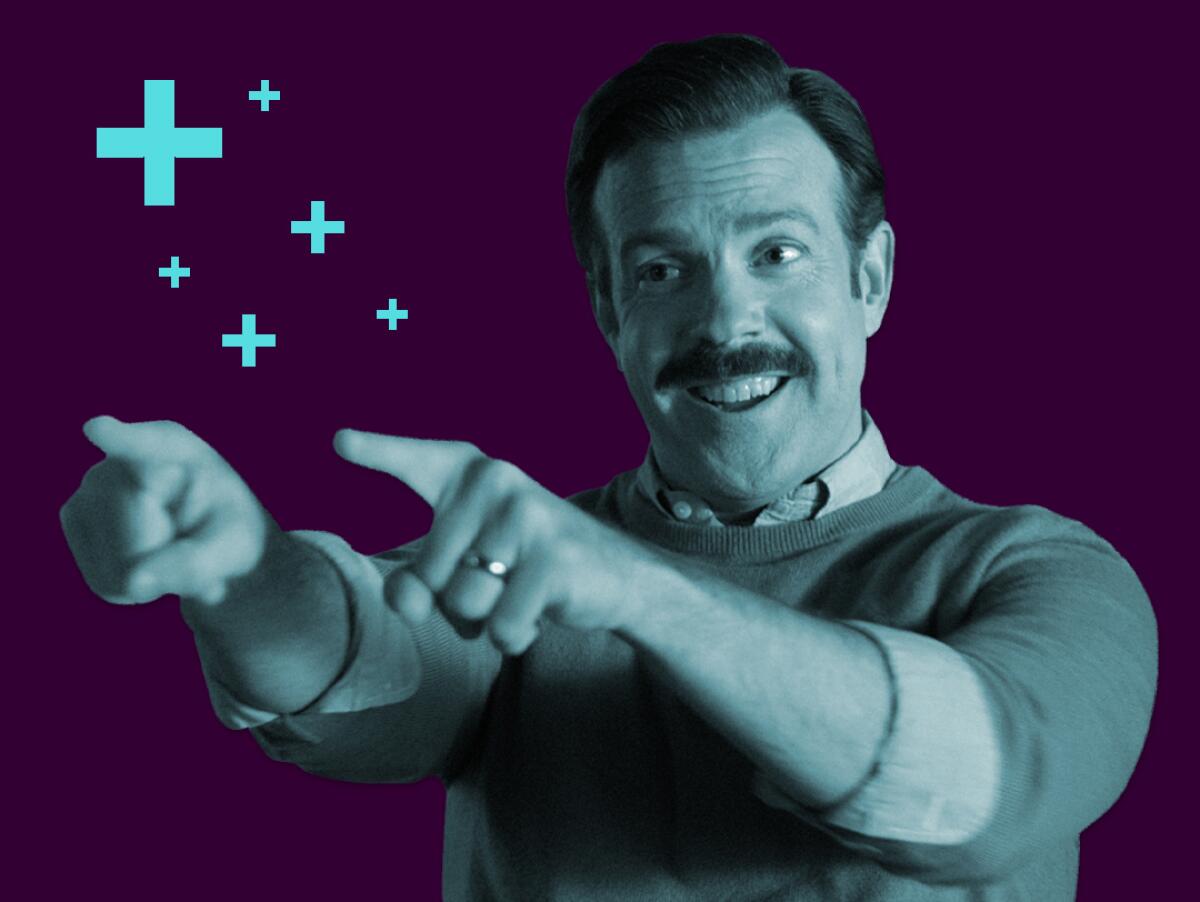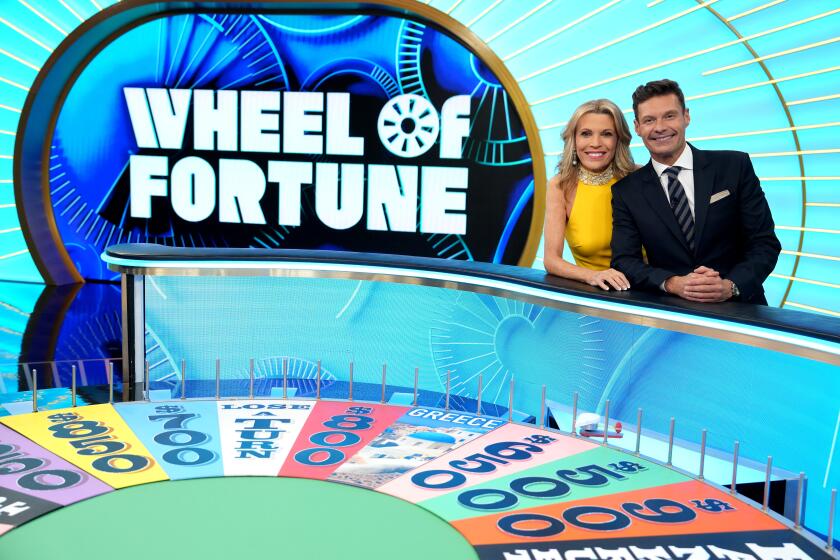Your streaming life is overwhelming. We get it. And we can help

This is the Aug. 17, 2021, edition of The Wide Shot, a weekly newsletter about everything happening in the business of entertainment. Sign up here to get it in your inbox.
And now for something a little different for the Wide Shot... I’m taking some time off this week, but of course, newsletters never sleep.
I’m joined by Matt Brennan, the Los Angeles Times’ senior editor of television and pop culture, who’s editing a new weekly newsletter called Screen Gab with the goal of helping streaming television fans answer the question “What should I watch?” It’s a good time for it, now that all of our attention spans are shot to hell. You can, and should, sign up here. I know I need help.
But Matt isn’t just a resource for what’s worth watching. Like me, he’s interested in how we watch and how that affects what gets made and how our favorite shows are released to the world. We spoke about some of our favorite industry topics.
Ryan Faughnder, host of The Wide Shot: Let’s get the shameless plug out of the way. What is Screen Gab, who should sign up and what’s it for? As someone who’s supposed to follow this stuff for a living, I’m still sometimes baffled when trying to figure out what to watch and where to watch it. Despite the supposed bottomless well of content, I still feel like I’m running out of things that are worth our time.
Matt Brennan, editor, television and culture: I’ll admit that I’m biased because I’m editing it, but in my mind Screen Gab is for anyone who watches TV or movies at home. And in the last 18 months especially, that means just about everyone — casual viewers, hardcore fans, industry insiders. Most of us are yearning to talk about what we’re consuming, too, so Screen Gab combines recommendations from The Times’ film and TV teams about what to watch and where to find it with the kinds of conversations you’re having over dinner, on Slack with colleagues, or in text threads with friends.
The whole idea is for it to be freewheeling, irreverent, fun. Whenever I have meetings at networks or agencies around town, I always say, “We don’t watch TV like we used to, so why should we cover it like we used to?” Screen Gab is an expression of that.
Faughnder: You and I are both extremely interested in this topic of the streaming wars and the horse race aspect of it. Who’s winning? Who’s falling behind?
There’s a consensus of sorts among industry folks that there are going to be three or four big winners fighting for market share, and that’s about the number of services that people are willing to subscribe to. The rest will have to partner, consolidate, fold or just be OK with having subscriber counts in the single-digit millions.
Disney+ and Netflix are easily up there at the top. HBO Max feels like it got off to a rough start but is pulling up nicely, especially with the Warner Bros. movies and shows like “Hacks,” “The White Lotus” and “Mare of Easttown.” Paramount+ and Peacock are in this kind of wobbler category, but both are still growing, as we saw in ViacomCBS and Comcast’s most recent earnings reports.
Am I missing anything? Is there a world that can sustain five to eight big streaming services instead of three to four? Is there anything content-wise on these second-tier streamers that is really drawing people in?

Brennan: You’ll be getting a note from the mucky-mucks at Apple about leaving them out, Ryan! And with “Ted Lasso” an Emmy favorite, no less!
In all seriousness, though, on the content side, I see no particular reason why five to eight streamers couldn’t survive, and thrive, any more than many hundreds of cable channels did in the heyday of the bundle. What will matter is their ability to differentiate their offerings — and their brand identity — enough to signal to consumers, “Hey, you! You like X? Then this is the monthly bill that will be worth it to you.”
Netflix, Disney+ and HBO Max have all positioned themselves well on this front, in my view: Netflix almost like one of the broadcast networks of yore, with the might of sheer subscriber and content volume; Disney+ like the cable networks of yore, with a mini-bundle that includes prestige (Hulu), family (Disney) and sports (ESPN) brands, along with the all-important Marvel/”Star Wars” portfolios; and HBO Max like, well, HBO of yore, with the power of critical acclaim, social media buzz and awards. Amazon Prime Video is in the same tier, though I’d argue it’s more because of the Prime than the Video at this point.
It’s where the rest fit in that I think is still shaking out. Peacock, Paramount+ and Apple TV+ are all producing excellent original series, but it’s not yet clear to me how they differ from their competitors in a macro sense, and whether what structural advantages they have — the Olympics, “The Good Fight” and Apple products, respectively — will be sustained in the long run. Which is why my dark horse pick to join the leading quartet is actually, at this point, Discovery+, which has distinguished itself by bundling unscripted programming from TLC, HGTV, Food Network, Discovery and beyond into an infinite channel-surfing platform of comforting TV.
Faughnder: Right, how could I forget Discovery+, especially when WarnerMedia and Discovery are planning to become one.
Netflix and Disney are also taking completely different approaches to producing and rolling out content. Netflix wants you to binge. Disney wants to use weekly drops of episodes spaced out in a way that if you care about Marvel or “Star Wars,” you can’t not have Disney+. Both strategies are about getting people hooked. People always complain about the quality versus quantity ratio at Netflix versus the more traditional distributors and producers. At the same time, we just saw Netflix film boss Scott Stuber sit for a big profile in Variety about how he is trying to make the case for why filmmakers should come to Netflix. You know, besides money. Does the quality-to-quantity batting average really matter for any of these companies, though?
Brennan: It depends on whose batting average you’re measuring and how. A given consumer may decide that they’ve grown weary of Netflix reality shows with bizarre premises, or that the CBS back catalog isn’t enough to keep them interested in Paramount+, and say, “I’m going to take my money elsewhere.” In the aggregate, those consumer choices are meaningful to the bottom line. But the very rise of these platforms means that all but the most engaged consumer likely has no idea who the distributor or producer is unless it’s one and the same with the place they are watching it. I’m paid to understand this stuff and sometimes my eyes roll back in my head trying to understand the economics of Universal selling a show to Netflix or a Warner Bros. show airing on ABC.
In my job — which is about determining what makes a good story about TV, as much as what makes a good TV show — I’m thinking much more along the lines of your point about Disney/Netflix: What about this show is going to catch the viewer’s interest? What are people going to be talking about, and when? And how do we get them to read our story, instead of a competitor’s? I think what Disney and HBO have hit upon in the last year especially is that the right type of show meted out weekly can bring a lot of sustained attention, and that has eaten into the dominance of the binge model.

Faughnder: On that point, we’re in this world where we feel like we know what’s a hit because … we just know. There’s social media chatter. The kinds of people who watch “The White Lotus” and “Succession” really like to talk about watching “The White Lotus” and “Succession” even if their actual numbers are fairly small. Now things are evolving to a place where we are getting useful, comparable data, even if the data are incomplete. Everyone makes fun of Netflix’s two-minutes-equals-a-view standard, but by now we have enough data from enough Netflix shows that you can make a reasonable claim that “6 Underground” viewership was disappointing given its budget. Netflix actually gives out more information than any of the streamers. Am I naive to be hopeful that streaming measurement is going to make sense soon?
Brennan: There was a time I got very exercised about the subject of streaming viewership, because it always felt like Netflix was crowing about what it wanted to crow about and everything else went unmentioned. Now that just about everyone has started their own platform, it feels like the playing field is more level, and we may begin to have a picture of the whole equation — even if it’s never going to mean quite what Nielsen overnights and Sunday morning box office numbers used to.
But I also think the phenomenon you mention, that relatively niche films and TV series tend to dominate the cultural conversation, has always been true in one form or another. I mean, “The Sopranos” finale in 2007, long before the age of streaming, had about one-third of the viewers of that year’s top-rated show, “American Idol.” But what do you remember: the talent show’s winner or the cut to black?
Faughnder: I definitely remember Kelly Clarkson winning, but I take your point. What would a standardized streaming ratings system look like? And isn’t talent going to force the issue as they argue for how much they should be paid? The Scarlett Johansson lawsuit against Disney isn’t exactly about this, but it does show how stars and other artists are not going to just sit back and take whatever they can get from their distributors, who think they have more power than ever. Writers, actors and producers want to know what the true market value of their product is.
Brennan: The goal of any platform, as I understand it, is to bring consumers to the platform, and then keep consumers on the platform. So if I were inventing a streaming ratings system, I think I would devise some sort of algorithm that assigned a score based on both the number of views and the median length of those views. A very popular streaming movie that also kept people’s attention through the whole running time would be a 100 on this scale, and a barely seen one that people clicked out of immediately would be a 0.
More broadly, information is always a boon to talent’s fight for a bigger — some would say fairer — piece of the pie. Think about the cast of “Friends” negotiating raises in tandem and demanding equal pay? Or the Chicks feuding with their label after Dan Rather talked about their record sales in an interview? If content is indeed king, it can only help the people who make that content to be able to point to the numbers and say, “Nice audience you got there. Would be shame if anything should happen to it.”
Stuff we wrote
— Anousha Sakoui and I gave the Scarlett Johansson-Disney debacle the “step back” treatment, writing about how the lawsuit shines a light on issues over streaming pay that are becoming a bigger and bigger deal in Hollywood.
— Robert Rodriguez on his new HBO Max deal and maverick career: “Just jack the system.”
— Kevin Hart and Snoop Dogg went viral with their “Olympic Highlights” program on Peacock. I spent some time at Hart’s Canoga Park studios to speak with the comedian and his executive team about the growth of their digital comedy brand Laugh Out Loud, and the pivot from subscription streaming to a more multi-pronged model.
— Hold onto your kielbasa. Meg James reports on a weird, escalating dispute between Discovery and the Polish government over the future of independent broadcasting. “At stake is Poland’s commitment to media freedom and democracy — as well as Discovery’s ambitions to become a global media giant.”
— Deaf people still face ‘outright discrimination’ in Hollywood. Amy Kaufman on how “CODA,” acquired by Apple for $25 million, broke the mold.
— Disney’s parks business is profitable for the first time since the pandemic struck. Also, Disney+ hit a better than expected 116 million subs, though most of the new customers are through the low-cost Disney+Hotstar service in India and Indonesia.
Deal time
Wendy Lee writes to the Wide Shot: The acquisition market continues to heat up. Trusted Media Brands, the parent company of Reader’s Digest, said Thursday it acquired L.A.-based streaming and social video company Jukin Media. Financial terms of the deal were not disclosed.

Jukin’s portfolio reaches more than 220 million people online and the acquisition quadruples Trusted Media Brands’ monthly audience reach, the companies said. Jukin has a library of more than 70,000 user generated media assets and last year the company licensed more than 2,000 video clips to use in ad campaigns. Jukin employs 270 people worldwide, with nearly 100 full-time employees at its L.A. headquarters.
Box office
“Free Guy” grossed $28.4 million in the US and Canada through Sunday. Ryan Reynolds over the weekend said Disney wants a sequel to the film. The movie was released exclusively in the theaters with a 45-day window due at least in part to contractual obligations inherited from Fox, as Disney CEO Bob Chapek alluded to during last week’s earnings call.
It’s the latest data point as analysts debate the effects of simultaneous streaming releases versus windows on box office returns. The film also marks a rarity for Disney: a piece of original I.P. that the company can now run through its franchise machine.
More stories from the week
— ‘The Lost Leonardo’ documentary reveals the true story behind a supposed Renaissance masterpiece. The wild ride treks from crate digging in New Orleans to the world of shady Russian oligarchs to the deserts of Saudi Arabia. (Esquire)
— FX’s John Landgraf said he would welcome Ryan Murphy’s return to the Disney (or Fox or whatever) fold if he were to leave Netflix, but also said it’s “premature” to speculate about what will happen with his deal. (THR)
— This Buzzfeed headline is a journey: The co-founder of the fact-checking site Snopes was writing plagiarized articles under a fake name.
— I’m fascinated by the ongoing battle over Nielsen’s accreditation. Media Rating Council says the measurement firm’s status was “threatened” by performance issues before its hiatus request. Variety’s latest.
Finally...
Nestflix is a website that provides Netflix-like tiles for movies that appear within movies. That’s all. There are some excellent “South Park” and “30 Rock” references (like the stone cold classic Tracy Jordan picture “Honky Grandma Be Trippin’”). It has always pained me that “Angels With Filthy Souls” is not real. Enjoy Nestflix.fun.
Inside the business of entertainment
The Wide Shot brings you news, analysis and insights on everything from streaming wars to production — and what it all means for the future.
You may occasionally receive promotional content from the Los Angeles Times.





